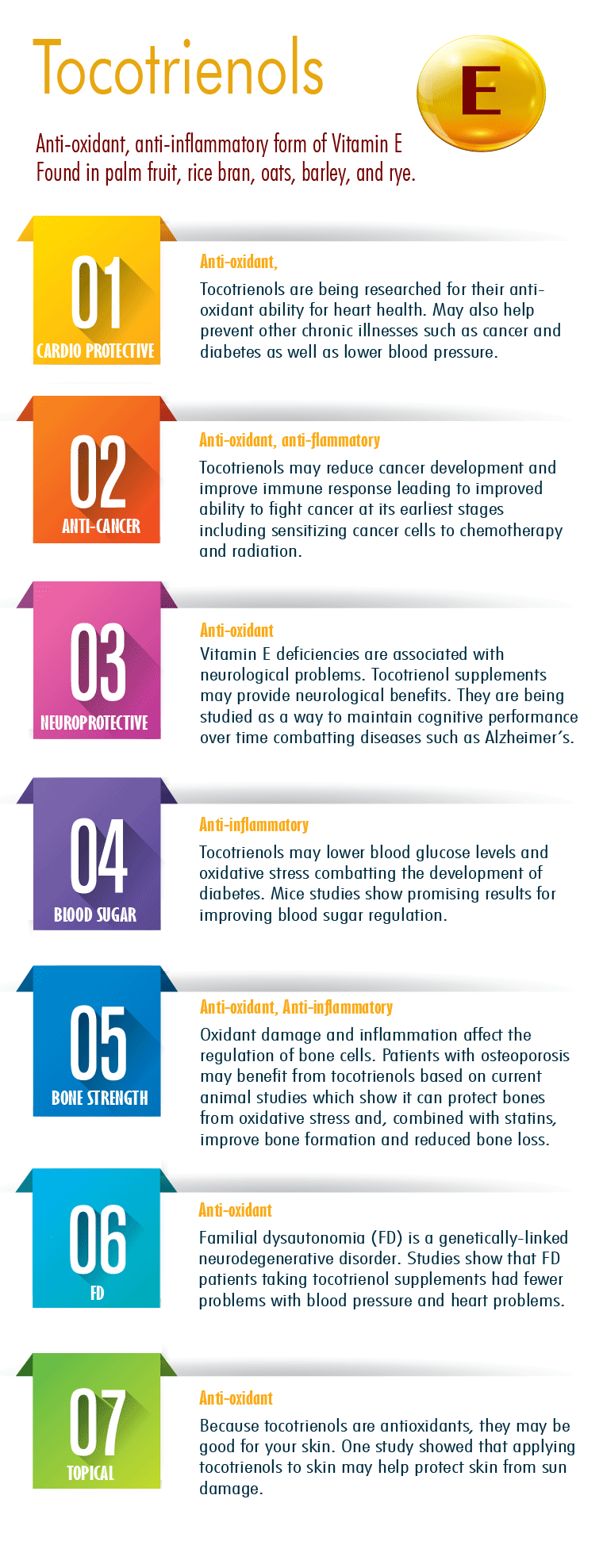Vitamin E – Tocotrienols
What are Tocotrienols?
Tocotrienols have antioxidant and anti-inflammatory properties (1) and are being researched for their ability to maintain a healthy heart, brain, and cholesterol. (2)
Tocotrienols show stronger antioxidant activity than tocopherols. They can be found as 4 different forms: alpha, beta, gamma, and delta. The difference depends on where the methyl group is placed. Researchers are looking at how these forms may affect the body differently. (3)
Tocotrienols are being studied for their effects on chronic diseases such as cardiovascular disease, cancer, and diabetes. Obesity increases the risk of developing all of these diseases, and eating nonfat foods is a part of some popular diets. It may feel counter-intuitive, but you need to eat fat to absorb tocotrienols. Fats are necessary to digest compounds like tocotrienols throughout the body. (4)
Making sure you eat tocotrienols may seem difficult because they are lumped with tocopherols under nutrition labels. Some vitamin E-rich foods have more tocopherols than tocotrienols. Palm oil, rice bran oil, and annatto oil are some of the richest sources of tocotrienols. (3) Tocotrienol supplements are also available, and using them is a good way of knowing what you are adding to your diet. The required intake of vitamin E to achieve additional benefits may be higher than the current required daily intake. (4)
Cardio Protective
The World Health Organization said that cardiovascular disease is the number one cause of mortality around the world. (1) Tocotrienols are being researched for their antioxidant ability for heart health.
How do antioxidants work? Reactive oxygen species (ROS) are formed in the body all the time; they are created when you eat food and use the energy from food. Environmental exposures, including cigarette smoke, air pollution, and UV light from the sun, can also lead to ROS. Antioxidants such as Vitamin E can help protect cells from the damaging effects of ROS. (5) This is important not just for maintaining a healthy heart, but also for preventing other chronic illnesses such as cancer and diabetes. (1) Research suggests that antioxidants can help reduce the number of plaques forming in blood vessels. (3) This may mean tocotrienols are able to prevent or delay chronic diseases and protect heart function. (5)
High blood pressure is a risk factor for strokes, heart attacks, heart failure, and chronic renal failure. In an animal study, tocotrienols lowered the systolic blood pressure of hypertensive rats . Through animal studies, it appears that tocotrienols help maintain blood pressure. (3)
High cholesterol is a contributing factor to cardiovascular disease. In addition to antioxidant abilities, tocotrienols can have an impact on lipids in the blood. Tocotrienols inhibit an enzyme in the production of cholesterol and so may contribute to healthy cholesterol levels. (6) In human studies, some trials have found that supplements of tocotrienols led to a decrease in total cholesterol and LDL. (7) This effect hasn’t been the same among all people across different trials. These differences may be due to different tocotrienol mixtures, the group of people studied, and/or the diet of the subjects involved. (6)
Anti-cancer
Because of their antioxidant and anti-inflammatory ability, tocotrienols are being researched for their cancer preventive abilities.
The DNA damage caused by ROS is a major cause of genetic mutation in cells. When this damage isn’t repaired, cancer can develop. Tocotrienols may protect against this DNA damage and reduce cancer development. (8)
A healthy immune system has to be fully functioning to be able to find and destroy tumor cells. Tocotrienols may enhance the immune response. This could lead to an improved ability to fight cancer at its earliest stages. (8) In rats, tocotrienols suppressed the development of cancer. (3) Vitamin E may also block the formation of carcinogens (cancer-causing compounds) in the stomach from foods. (5)
Tocotrienols are also useful in inhibiting the tumor-initiating cells. These initiator cells start a tumor’s growth and can be difficult to kill. Being able to stop them would mean less cancer growth. (8)
Additionally, tocotrienols may be useful in the treatment of cancer. In lab studies, tocotrienols were found to selectively affect cancer cells but not the healthy surrounding cells (8). Tocotrienols are being studied for their use alongside traditional cancer treatments. Recent studies suggest that tocotrienols may sensitize cancer cells to chemotherapy. It may also sensitize cancer cells to radiation while protecting other cells. (8) This kind of synergistic activity may be useful for future cancer treatment practices. (7)
All of this anticancer activity is dependent on how well tocotrienols are taken into tumor cells as well as healthy cells. Tocotrienols are able to accumulate in cells, based on the amount of tocotrienols taken and the amount of time they are taken. (7)

Neuroprotective
Vitamin E deficiencies are associated with neurological problems. Although most diets provide enough tocopherols and tocotrienols, tocotrienol supplements may provide additional neurological benefits. (4)
One hypothesis for cognitive decline is based on the accumulation of ROS damage to the brain over time. Your brain uses a lot of oxygen and has lots of fatty acids. Over your lifetime, you may experience more ROS damage in the brain, which could cause neurodegeneration. As mentioned before, tocotrienols are antioxidants and can help protect cells from ROS damage. Tocotrienols are being studied as a way to maintain cognitive performance over time, but more research is needed. (5) Tocotrienols are being studied for people already dealing with the effects of neurodegeneration. One study showed that vitamin E slowed down Alzheimer’s patients’ functional deterioration. (5)
Blood Sugar Regulation
Oxidative stress is considered to be important in the development of diabetes and complications associated with it. Animal studies have shown that tocotrienols lowered blood glucose levels and oxidative stress. Combining tocotrienols with insulin in rats led to improved inflammatory responses. (3) Studies in mice taking tocotrienols have also shown improvements using glucose and insulin. (4) The use of tocotrienols shows promising results in animal models for improving blood sugar regulation and helping diabetic patients.
Bone Strengthening
To stay healthy and strong, bones constantly go through bone remodeling. Bone cells regulate bone resorption and formation, but dysfunctional cells can lead to bone loss [10]. Patients with osteoporosis may benefit from tocotrienols based on current research. ROS damage and inflammation affect the regulation of bone cells. Using on tocotrienol’s antioxidant and anti-inflammatory properties, tocotrienol helped prevent bone loss in animal studies. (7) Tocotrienols have been found to protect rats’ bones from oxidative stress. (3) A study showed that tocotrienols combined with statins improved bone formation and reduced bone loss. (11)This research is promising for improving adult bone health.
Familial dysautonomia
Familial dysautonomia (FD) is a genetically-linked neurodegenerative disorder. (3) Development is impaired, and patients may suffer from problems with their lungs, heart, gastrointestinal system, coordination, bones, and neurology. Because it affects so many body systems, patients have high morbidities and mortalities. (12)Studies have found that FD patients taking tocotrienol supplements experienced fewer problems with blood pressure and heart problems than their FD peers who didn’t take supplements. (3)Some patients may experience improvements in some clinical outcomes, but further research is needed to understand how tocotrienols can be beneficial for FD patients. (12) Potentially, tocotrienols may improve the lives of people with this disease. (3)
Topical application
Being out in the sun can damage your skin. The ultraviolet radiation leads to more ROS, which is bad for you. Because tocotrienols are antioxidants, they may be good for your skin. One study showed that applying tocotrienols to the skin may help protect skin from sun damage. Studies don’t support the use of applying tocotrienols to skin for scar reduction. (7)
Safety
Consuming Vitamin E in food isn’t associated with any adverse effects. (5) There are limited studies on tocotrienol safety, and most of these suggest they are relatively safe. (7) There isn’t reliable information for how tocotrienols affect pregnancy or breastfeeding, and it is recommended to avoid these supplements while pregnant or nursing. (2) With Vitamin E supplements, there are potential adverse outcomes due to clotting. If you are on an anticoagulant or antiplatelet medication, such as warfarin (Coumadin®), you may have an increased risk of bleeding. (5) There are tocotrienol studies that suggest tocotrienols don’t increase the risk of bleeding but be sure to talk to your doctor before adding tocotrienol supplements if you are taking anticoagulant or antiplatelet medications. (7) Because tocotrienols might lower blood sugar, they may not be recommended for individuals with diabetes. Check with your health care provider before adding in supplements, and you may need to closely monitor your blood sugar. (2) If on cancer chemotherapy or radiation, talk to your oncologist about the use of supplements. Some studies suggest antioxidant supplements could reduce the effectiveness of cancer therapy. (5) For some people taking simvastatin (brand name Zocor®) and niacin, taking Vitamin E supplements with Vitamin C, selenium, and beta-carotene supplements stopped improvements in HDL cholesterol levels. (5)
References
1. Ramanathan, N., Tan, E., Loh, L. J., Soh, B. S., & Yap, W. N. (2018). Tocotrienol is a cardioprotective agent against ageing-associated cardiovascular disease and its associated morbidities. Nutrition & Metabolism, 15, 6.
2. TOCOTRIENOLS: Uses, Side Effects, Interactions and Warnings – WebMD. (n.d.). Retrieved February 9, 2018
3. Aggarwal, B. B., Sundaram, C., Prasad, S., & Kannappan, R. (2010). Tocotrienols, the Vitamin E of the 21st Century: It’s Potential Against Cancer and Other Chronic Diseases. Biochemical Pharmacology, 80(11), 1613–1631.
4. Shahidi, F., & de Camargo, A. C. (2016). Tocopherols and Tocotrienols in Common and Emerging Dietary Sources: Occurrence, Applications, and Health Benefits. International Journal of Molecular Sciences, 17(10). https://doi.org/10.3390/ijms17101745
5. Office of Dietary Supplements – Vitamin E. (2016, November 3). Retrieved February 9, 2018, from https://ods.od.nih.gov/factsheets/VitaminE-HealthProfessional/
6. Chin, K.-Y., Pang, K.-L., & Soelaiman, I.-N. (2016). Tocotrienol and Its Role in Chronic Diseases. Advances in Experimental Medicine and Biology, 928, 97–130. https://doi.org/10.1007/978-3-319-41334-1_5
7. Meganathan, P., & Fu, J.-Y. (2016). Biological Properties of Tocotrienols: Evidence in Human Studies. International Journal of Molecular Sciences, 17(11). https://doi.org/10.3390/ijms17111682
8. Ling, M. T., Luk, S. U., Al-Ejeh, F., & Khanna, K. K. (2012). Tocotrienol as a potential anticancer agent. Carcinogenesis, 33(2), 233–239. https://doi.org/10.1093/carcin/bgr261
9. Xia, W., & Mo, H. (2016). Potential of tocotrienols in the prevention and therapy of Alzheimer’s disease. The Journal of Nutritional Biochemistry, 31, 1–9. https://doi.org/10.1016/j.jnutbio.2015.10.011
10. Muhammad, N., Luke, D. A., Shuid, A. N., Mohamed, N., & Soelaiman, I. N. (2013). Tocotrienol supplementation in postmenopausal osteoporosis: evidence from a laboratory study. Clinics (Sao Paulo, Brazil), 68(10), 1338–1343. https://doi.org/10.6061/clinics/2013(10)08
11. Abdul-Majeed, S., Mohamed, N., & Soelaiman, I.-N. (2013). A review on the use of statins and tocotrienols, individually or in combination for the treatment of osteoporosis. Current Drug Targets, 14(13), 1579–1590.
12. Cheishvili, D., Maayan, C., Holzer, N., Tsenter, J., Lax, E., Petropoulos, S., & Razin, A. (2016). Tocotrienol Treatment in Familial Dysautonomia: Open-Label Pilot Study. Journal of Molecular Neuroscience: MN, 59(3), 382–391.
13. Meganathan, P., Jabir, R. S., Fuang, H. G., Bhoo-Pathy, N., Choudhury, R. B., Taib, N. A., … Chik, Z. (2015). A new formulation of Gamma Delta Tocotrienol has superior bioavailability compared to existing Tocotrienol-Rich Fraction in healthy human subjects. Scientific Reports, 5, 13550. https://doi.org/10.1038/srep13550
14. Ahsan, H., Ahad, A., & Siddiqui, W. A. (2015). A review of characterization of tocotrienols from plant oils and foods. Journal of Chemical Biology, 8(2), 45–59.
15. Fu, J.-Y., Che, H.-L., Tan, D. M.-Y., & Teng, K.-T. (2014). Bioavailability of tocotrienols: evidence in human studies. Nutrition & Metabolism, 11, 5. https://doi.org/10.1186/1743-7075-11-5
16. NCI Drug Dictionary. (n.d.). [nciAppModulePage]. Retrieved February 8, 2018, from https://www.cancer.gov/publications/dictionaries/cancer-drug
17. Baumann, L. S., & Spencer, J. (1999). The effects of topical vitamin E on the cosmetic appearance of scars. Dermatologic Surgery: Official Publication for American Society for Dermatologic Surgery [et Al.], 25(4), 311–315.
18. Chun, J., Lee, J., Ye, L., Exler, J., & Eitenmiller, R. R. (2005, October 20). Tocopherol and tocotrienol contents of raw and processed fruits and vegetables in the United States diet – ScienceDirect. Retrieved February 9, 2018, from https://www.sciencedirect.com/science/article/pii/S0889157505000967
19. Tocotrienol. (n.d.). Retrieved February 9, 2018, from https://pubchem.ncbi.nlm.nih.gov/compound/9929901
20. Sen, C. K., Khanna, S., & Roy, S. (2004). Tocotrienol: the natural vitamin E to defend the nervous system? Annals of the New York Academy of Sciences, 1031, 127–142. https://doi.org/10.1196/annals.1331.013
21. Tocotrienols | Michigan Medicine. (2015, March 24). Retrieved February 9, 2018, from http://www.uofmhealth.org/health-library/hn-2918000
22. Wang, K. (n.d.). Tocotrienols Benefits & Side Effects: Pros & Cons of Tocotrienols | Natural Remedies.org. Retrieved February 8, 2018, from https://www.naturalremedies.org/tocotrienols/



